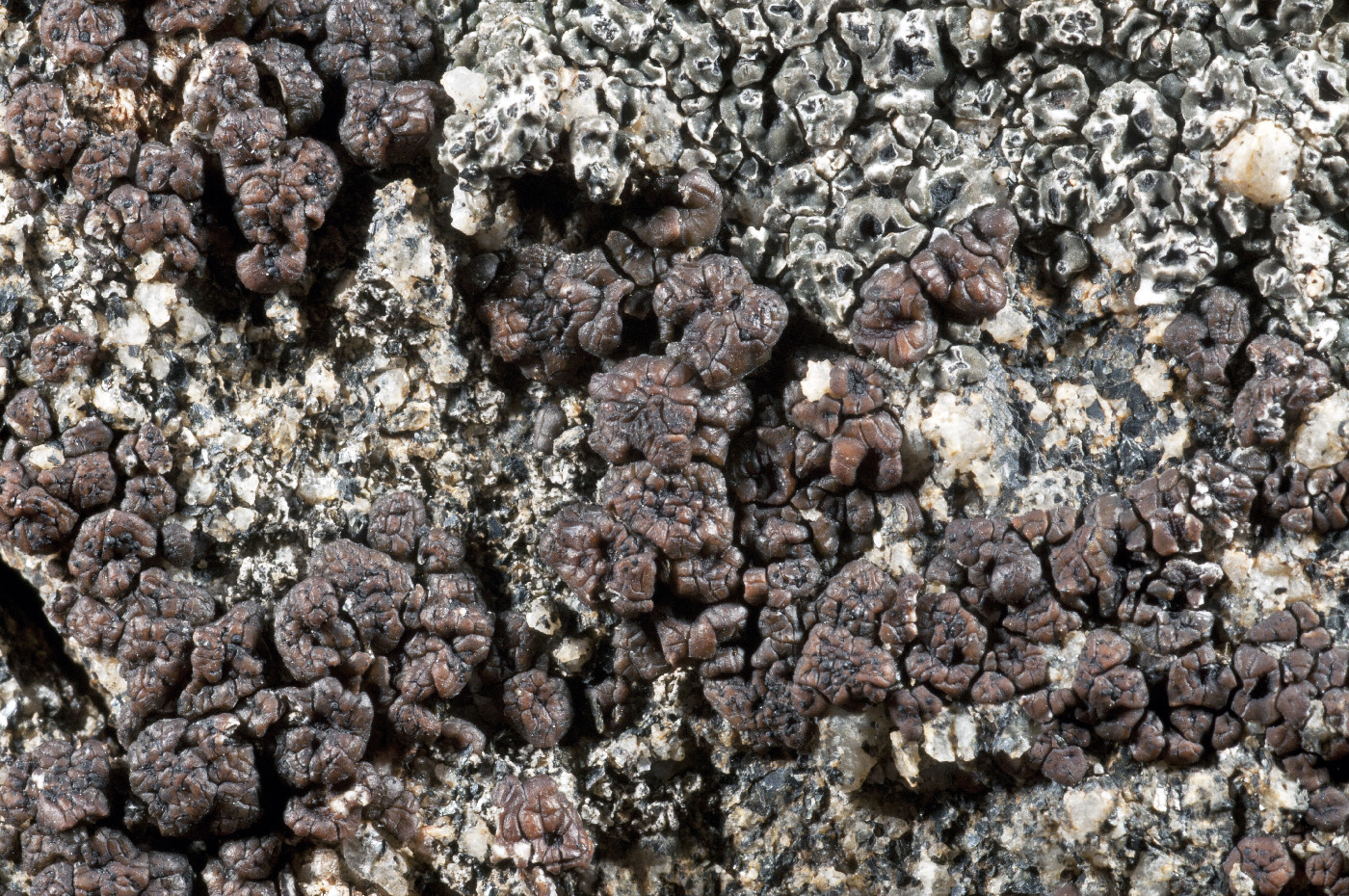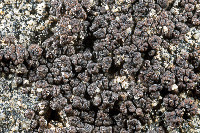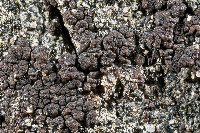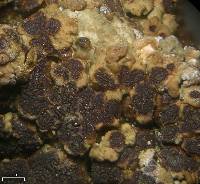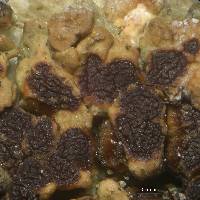
Consortium of Lichen Herbaria
- building a Global Consortium of Bryophytes and Lichens as keystones of cryptobiotic communities -
- Home
- Search
- Images
- Species Checklists
- US States: O-Z >
- US National Parks
- Central America
- South America
- US National Parks
- Southern Subpolar Region
|
|
|
|
Family: Acarosporaceae
|
Nash, T.H., Ryan, B.D., Gries, C., Bungartz, F., (eds.) 2007. Lichen Flora of the Greater Sonoran Desert Region. Vol 3. Thallus: squamulose, overall up to 4 mm in diam. squamules: round to irregular, with a stipe, up to 2 mm. in width, up to 1-2 mm thick, contiguous and usually imbricate; rim: down- or up-turned, crenulate or irregularly lobed; lobes: elevated. ±spatulate, becoming contorted upper surface: light to dark brown, dull, convex, with fissures and wrinkles, epruinose lateral cortices: paraplectenchymatous, ±70 µm thick; cells usually visible in water, 1-4 µm wide, various, but often clearly seen as lumina in anticlinal prosoplectenchyma rising through algal layer in hyphal bundles; syncortex: 10-20 µm thick, periclinal prosoplectenchyma often visible; eucortex: upper layer, amber to dark brown, 7-10 µm thick, lower layer unpigmented and 40-60 µm thick algal layer: upper side undulate, usually penetrated with thick hyphal bundles, becoming thin or very jagged medulla: white, ±prosoplectenchymatous, lower surface: white, algae partly visible, ecorticate attachment: forming a thick stipe, 1-1.5 mm tall Apothecia: one to six per squamule, punctiform, sometimes with a thalline collar pushed up by expansion of the apothecium disc: brownish red, round, deeply immersed, concave, 0.1-0.3 mm in diam., in especially high elevation specimens discs sometimes becoming expanded to 1 mm, often singular, sometimes forming pseudo-lecanorine verrucae among squamules parathecium: indistinct epihymenium: reddish brown, in a coherent gel, c. 10 µm thick hymenium: hyaline, 130-170 µm tall; paraphyses: 1-2 µm wide at base, apices usually more closely septate in upper 30 µm, barely expanded to 2-2.5 µm, usually more closely septate in upper 30µm with ±black pigment hood subhymenium: hyaline, 30-50 µm thick; hypothecium: indistinct asci: clavate, 80-125 x 25-35 µm, 100+-spored ascospores: hyaline, simple, ellipsoid, 3-6 x 1-2.2 µm, often quite various in size Pycnidia: often abundant, globose, c. 50 µm deep by 70 µm tall, wall hyaline conidia: bacilliform, 3.2-4.1 x 1-2.1 µm, narrow to more broadly ellipsoid Spot tests: all negative but apparently cortical pigment diffuses in K looking yellowish or reddish brown Secondary metabolites: none detected Substrate and ecology: lichenicolous on at least Aspicilia species, and free-living on acidic rocks in full sun World and Sonoran distribution: locally common in Arizona, southern California and Baja California; holotype from Adamana, Arizona (UPS!) Notes: The paraphyses in the holotype are less wide at base (1-2 µm vs. 2-3.5 µm ), the cortex thicker (c. 70 µm vs. 30-40 µm) and hymenium often taller (150-170 µm vs. 80-100 µm) than the values given in Magnusson's 1956 key for North American Acarospora species, and consequently, it would have been impossible to key out. The description above is consistent with the holotype and other specimens examined. Acarospora obnubila is initiallylichenicolous, a juvenile parasite. It has been observed in California growing out of Aspicilia species on Eureka Peak in the Mojave Desert in Joshua Tree National Park and in the White Mountains in Inyo-Mono Counties. But usually it is collected growing simply among other lichens at the stage when its scattered squamules have become independent. Eventually it forms pure populations. Its stipitate architectural pattern is similar to that of A. thamnina. As its stipe grows, sometimes fine soil particles are trapped beneath the squamules. The undersides of the squamules are often buried and the lobes contorted, making the thallus look areolate, unless one removes the soil particles. The squamules divide downward straight through the stipe. As in A. thamnina, competition for space with other lichens definitely stimulates stipe development and elongation. It is possible other undescribed species may key out as A. obnubila. In some specimens the stipes may be poorly developed as well as not having a well-formed jagged algal layer, and these may be impossible to determine unless one can compare several specimens from the same area. It is polymorphous, but stipe and chemistry are consistent characters. |
|
|
|
Powered by Symbiota

